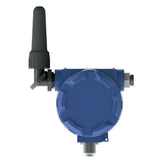Steam Trap Monitoring ST6700, AIM ISA100 w/o Battery
[ Contact Us For Availability ]
Armstrong Intelligent Monitoring (AIM) Model: ST6700
ST6700 Steam Trap Monitor
Armstrong Intelligent Monitoring Model ST6700 is a wireless monitoring technology that efficiently monitors and evaluates steam trap operation. The AIM® ST6700 identifies the conditions of a steam trap to determine significant problems that could put your operation at risk. The AIM® ST6700 can accurately detect potential issues such as plugged and blow-through steam traps, which can cause a range of issues including, but not limited to failed equipment, loss of product, and safety concerns. Immediate failure notification from the AIM® ST6700 helps identify the root cause while minimizing production losses and reducing energy consumption. Using non-intrusive technology combined with ISA100, the AIM® ST6700 is the ideal solution for any temporary or permanent 24/7 steam trap monitoring.
Operation
The Armstrong ST6700 AIM® transmitter is designed to continuously monitor any type of steam trap. It utilizes a combination of hardware and integrated algorithms to accurately detect steam trap conditions. The hardware consists of an acoustic sensor (Piezo) and a temperature sensor (Thermistor). The integrated algorithms are patented, proprietary code designed by Armstrong to provide actual steam trap conditions based on inputs from the hardware. When applied to a steam trap, the device will display and/or wirelessly transmit the current condition of the steam trap. The device is mounted onto the inlet pipe of the steam trap (≤ 6”) by an Armstrong designed waveguide. The ST6700 has built-in algorithms, which perform a series of diagnostic checks in order to determine the condition of the steam trap.
The first stage validates the surface temperature of the steam line and compares it with the configurable temperature set point. The temperature sensor detects the skin temperature at the inlet of the steam trap and is displayed as Channel 10. Channel 10 is compared to the configurable set temperature, which is displayed as channel 11. If channel 10 is less than channel 11, then the steam trap is cold. This could be due to a failed plugged steam trap, or there is no steam distributed to the steam trap. If the steam trap is cold, the transmitter will return a channel 9 value of 2.
A channel 9 value of “2” means the steam trap is in a cold condition.
If the channel 10 is greater than channel 11, there is steam being distributed to the trap causing the device to go into the second stage of diagnostics. In the second stage, the ST6700 listens to the operation of the trap to determine if there is steam loss through the steam trap’s internal orifice. The Piezo sensor has been tuned to a specific frequency. Through extensive lab and field testing by Armstrong, this range has been determined to be the optimal frequency range to detect a trap passing live steam while filtering out background noise. This acoustic signature is analyzed by Armstrong’s patented algorithm to determine if the steam trap is in a blow-thru condition (i.e. losing live steam). If the algorithm determines that the trap is in normal operation, then the ST6700 will publish a channel 9 value of 1.
A channel 9 value of “1” means the trap is in a good condition.
If the algorithm determines that the trap is losing live steam, the ST6700 will publish a channel 9 value of 3.
A channel 9 value of “3” means the trap is in a blow-thru condition.
UL LLC Approval - United States
- Intrinsic Safe for Class I/II/III, Division 1, Groups A, B, C, D, E, F, and G
- Zone 0, for Class I, Group IIC
- Temperature Code: T4 [275ºF (135ºC)]
- Ambient Temperature Range: Tamb -40ºC to 70ºC (-40ºF to 158ºF)
- For use with Armstrong model D64519 lithium metal battery only
- Standards used for Compliance:
- UL 913, Ed. 8; UL 60079-0, Ed. 7; UL 60079-11, Ed. 6




